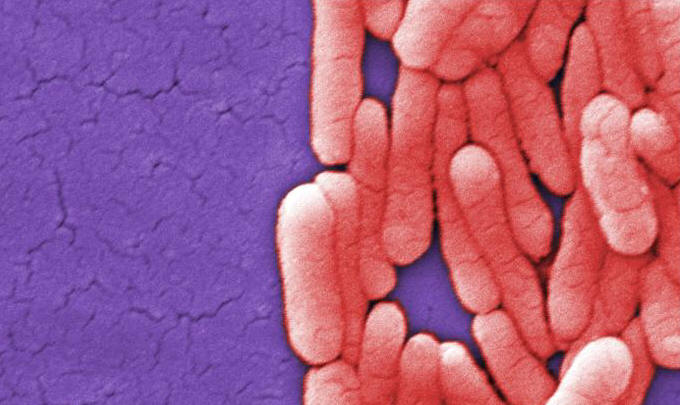Salmonella typhimuriumSalmonella typhimurium is a Gram-negative, rod-shaped bacterium (Figure 1). When grown on ordinary agar, the organism forms spherical smooth colonies about two to four millimeters in diameter. When grown on Hektoen enteric agar, colonies are bluish-green with black centres, indicating that the species does not ferment lactose (common to many Salmonella species). The use of Hektoen enteric agar is designed for detection of these types of bacteria.
Figure 1. Under a very high magnification of 15000 X, this colorized scanning electron micrograph reveals the presence of numbers of clustered Gram-negative Salmonella typhimurium bacteria, which had been grown in a pure culture. Movement is accomplished with a peritrichous flagella arrangement, but does not produce endospores. Some of the metabolic features that can help identify the bacteria include being lactose negative, citrate positive, lysine decarboxylase positive, gelatin hydrolysis negative, and the production of hydrogen sulfide. S. typhimurium can be found on certain food items, and also within an infected host's fecal matter. Stool or food samples thought to contain the pathogen are isolated and analyzed. The bacteria is incubated at 37°C and allowed to grow for 18 to 24 hours before being plated out onto selective agar. The broth most commonly used for selective identification of S. typhimurium is Rappaport-Vassiliadis soy broth. This pathogen is infamously known for causing food poisoning in humans, resulting in gastroenteritis in humans and other mammals. Food poisoning often occurs when a person consumes uncooked meat or comes in contact with the fecal matter of an infected individual. In nature, S. typhimurium may survive several years in the soil. Once the organism enters the host, symptoms are not noted until 12 to 24 hours have passes. The most common symptoms include: diarrhea, vomiting, and fever; this lasts between two to five days. S. typhimurium infects the host by penetrating the intestinal mucosa and migrating to the spleen and liver where it causes systematic disease (Rosenberger et al., 2000). The most common risk factor is ill prepared food, such as undercooked beef, pork, and lamb. Handling uncooked meat may contaminant hands, plates, kitchenware, and grounding the meat may also cause multiplication of the bacteria, increasing the risk of infection. Recall that grounding the meat increases its surface area; this exposes S. typhimurium, an aerobic bacteria, to greater amounts of atmospheric oxygen, and in turn, providing it with its desired growth environment that is oxygen-enriched. Moreover, food poisoning normally will clear up on its own in healthy individuals. However, immunocompromised, elderly, young children, organ-transplant recipients, people receiving treatment for cancer and pregnant woman are at greater risk of infection, as it may cause typhoid-like symptoms if left untreated. S. typhimurium evades the immune system of its host by first being taken up by the epithelial layer of the small intestine or macrophages of the small intestine and replicating within specialized vacuoles. The pH level within these vacuoles that are produced as a result of engulfment induces the production of bacterial gene products required for its survival in the epithelial cell of phagocyte (Rosenberger et al., 2000). Moreover, as with all Gram-negative bacteria, the outer membrane contains lipopolysaccharide (LPS), which contains the lipid A endotoxin. Once this is released, it can cause shock, a condition that creates an excessive immune reaction that can be fatal. Another virulence factor is enterochelin, which is a chelating agent created by these bacteria. Iron is required for bacterial growth, and this agent allows iron to be sequestered from the host body for use by the bacteria only (Yancey et al., 1979). If the bacteria can obtain the iron, its virulence will increase within the host. In order to prevent food poisoning caused by species of the genus Salmonella, attenuated Salmonella vaccine strains have been developed by introducing mutations into the bacterium that diminish its overall growth. Several strains have been attenuated (deactivated or killed) through the introduction of auxotrophic (nutritional) defects, which slow the growth of the bacterium by preventing it from synthesizing needed biomolecules such as amino acids. A more recent strain contained mutated DNA adenine methyltransferase (Dam) gene, which is essential for DNA repair (Pier et al., 2004). References: Pier, G.B., Lyczak, J.B., & Wetzler, L.M. (2004). Immunology, Infection, and Immunity. Washington: ASM Press. Rosenberger, C., Scott, M., Gold, M., Hancock, R., & Finlay, B. (2000). Salmonella typhimurium Infection and Lipopolysaccharide Stimulation Induce Similar Changes in Macrophage Gene Expression. The Journal of Immunology, 5894-5904. Yancey, R., Breeding, S., & Lankford, C. (1979). Enterochelin (Enterobactin): Virulence Factor for Salmonella typhimurium. Infection and Immunity, 174-180. |

